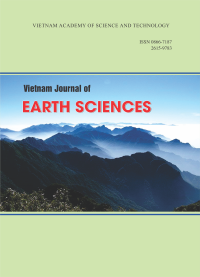XU HƯỚNG VẬN CHUYỂN TÍCH TỤ TRẦM TÍCH TRÊN PHẦN CHÂU THỔ NGẦM VEN BỜ BIỂN ĐỒNG BẰNG SÔNG MÊ KÔNG
Author affiliations
DOI:
https://doi.org/10.15625/0866-7187/33/4/545Abstract
Sediment transportation and deposition on the subaqueous Mekong River Delta
The development of subaqueous delta of Mekong Delta has been investigated sparsely. The subaqueous delta is a place of intensive land-ocean interaction taking place. This geomorphologic sub-unit is also highly susceptible with the present sea level rise in the state of global warming climate. The investigation of the sediment transportation and deposition on the subaqueous delta was done on 190 surface samples collected from the two cruises in 2007 and 2008.
Besides, the estimation of coastal current in the study area was carried out with a 2D hydrodynamic model (MIKE 21) in order to define the coastal current regime more clearly. The distribution of grain size parameters, sand content, mud content and the calculation result of coastal current indicate that: (1) five deposition regions are separated relatively from Mekong river mouths to Ca Mau Peninsula consisting of: two dominating sandy regions as in front of Mekong river mouths and near the Ganh Hao river mouth; two dominating muddy regions occur as along the coast of Soc Trang-Bac Lieu and in the west of Ca Mau peninsula; and one sand-mud deposition region from the middle place of Ganh Hao and Bo De to Hon Khoai Island; (2) the sediment is transported mainly southwestwards to Ca Mau Cape, when moving past
the Ca Mau Cape the sediment is transported northwestwards and northwards; (3) The area around Ca Mau Peninsula from Bo De to Cua Lon Bay is a depositional center of the subaqueous delta.







